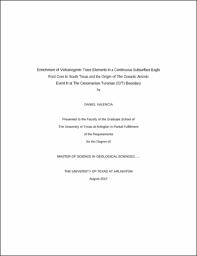
ATTENTION: The works hosted here are being migrated to a new repository that will consolidate resources, improve discoverability, and better show UTA's research impact on the global community. We will update authors as the migration progresses. Please see MavMatrix for more information.
Show simple item record
| dc.contributor.advisor | Basu, Asish R. | |
| dc.contributor.advisor | Hunt, Andrew | |
| dc.creator | Valencia, Daniel | |
| dc.date.accessioned | 2019-08-29T18:31:23Z | |
| dc.date.available | 2019-08-29T18:31:23Z | |
| dc.date.created | 2017-08 | |
| dc.date.issued | 2017-12-13 | |
| dc.date.submitted | August 2017 | |
| dc.identifier.uri | http://hdl.handle.net/10106/28640 | |
| dc.description.abstract | The Upper Cretaceous Eagle Ford Shale of South Texas is a dark grey to black, sporadically laminated, organic rich carbonaceous mud rock located in the subsurface (~13,000), of the hydrocarbon producing shale-oil formation. This black shale formation was deposited contemporaneously worldwide across the Cenomanian-Turonian (C/T) boundary and records the Oceanic Anoxic Event (OAE-II).
Geochronological and geochemical analysis of a ~300ft long continuous South Texas Eagle Ford Shale core was conducted to further constrain the sub-surface nature of the formation. Major, minor and trace element concentrations were analyzed by ED-XRF to characterize the local geochemical heterogeneity in the formation. Total Organic Carbon (TOC), δ13C and δ18O analysis were carried out to constrain and correlate the recorded Oceanic Anoxic Event II (OAEII) in the core.
Volcanic ash beds were sampled at the top and middle of the Eagle Ford and by mineral separation yielding abundant non-detrital zircons for geochronological dating. The U-Pb zircon ages agree with the top of the Eagle Ford and with the inferred middle Eagle Ford, (C/T) boundary. Using this horizon, the onset of OAE2 can be further constrained and correlated with the positive δ13C excursion.
With a definitive constraint for OAE2 established, this key interval was analyzed at a higher resolution using Energy Dispersive X-ray Fluorescence (ED-XRF). The high-resolution sampling of the core shows ~80-99% increase in concentrations of Cr, Cu, Ni, Mo and Zn over the average Post Australian Archean Shale(PAAS), representative of average continental crust. These findings show significantly increased volcanogenic trace metal input correlating with increased TOC and positive δ13C values at the C/T dated zircon horizon. These volcanogenic-rich intervals reach peak values before the onset of OAEII and at the maximum values for the positive δ13C isotope excursion directly after the C/T inferred ash bed. Extensive research has been conducted to construct a robust stratigraphic framework to present a better understanding in the timing and nature of the conditions present during the deposition of the Cenomanian-Turonian Eagle Ford Shale of South Texas. | |
| dc.format.mimetype | application/pdf | |
| dc.subject | Eagle Ford Shale | |
| dc.subject | Geochemistry | |
| dc.title | Enrichment of Volcanogenic Trace Elements in a Continuous Subsurface Eagle Ford Core in South Texas and the Origin of The Oceanic Anoxic Event II at The Cenomanian-Turonian (C/T) Boundary | |
| dc.type | Thesis | |
| dc.degree.department | Earth and Environmental Sciences | |
| dc.degree.name | Master of Science in Earth and Environmental Science | |
| dc.date.updated | 2019-08-29T18:32:28Z | |
| thesis.degree.department | Earth and Environmental Sciences | |
| thesis.degree.grantor | The University of Texas at Arlington | |
| thesis.degree.level | Masters | |
| thesis.degree.name | Master of Science in Earth and Environmental Science | |
| dc.type.material | text | |
Files in this item
- Name:
- VALENCIA-THESIS-2017.pdf
- Size:
- 4.452Mb
- Format:
- PDF
This item appears in the following Collection(s)
Show simple item record


